Blog & Latest Updates
Fly Fishing Articles
Insects by Common Name


Insect Order Ephemeroptera (Mayflies)
Taxonomic Navigation -?-
Kingdom
Animalia (Animals)
» Phylum
Arthropoda (Arthropods)
» Class
Insecta (Insects)
» Order Ephemeroptera (Mayflies)
8 families aren't included.
Common Name
| Match | Common Name |
| Mayflies |
This is page 77 of specimens of Ephemeroptera. Visit the main Ephemeroptera page for:
- The behavior and habitat of Ephemeroptera.
- 67 underwater pictures of Ephemeroptera.
Pictures of 828 Mayfly Specimens:
Male Drunella coloradensis (Small Western Green Drake) Mayfly Spinner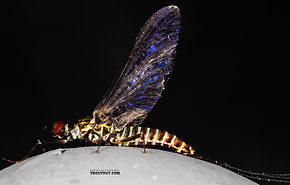 View 9 PicturesThis spinner molted from this dun, or possibly one other dun I had in the same container that looked just like it.
View 9 PicturesThis spinner molted from this dun, or possibly one other dun I had in the same container that looked just like it.
 View 9 PicturesThis spinner molted from this dun, or possibly one other dun I had in the same container that looked just like it.
View 9 PicturesThis spinner molted from this dun, or possibly one other dun I had in the same container that looked just like it.Collected July 28, 2019 from Mystery Creek #199 in Washington
Added to Troutnut.com by Troutnut on July 30, 2019
Added to Troutnut.com by Troutnut on July 30, 2019
Female Baetidae (Blue-Winged Olives) Mayfly Dun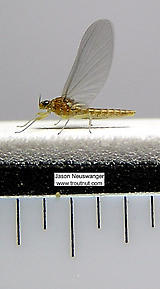 View 3 PicturesThis little gal is of the usual size for Baetid mayflies, around size 20. She came with two tails, but it's kind of hard to transport size 20 mayflies without a little bit of damage.
View 3 PicturesThis little gal is of the usual size for Baetid mayflies, around size 20. She came with two tails, but it's kind of hard to transport size 20 mayflies without a little bit of damage.
 View 3 PicturesThis little gal is of the usual size for Baetid mayflies, around size 20. She came with two tails, but it's kind of hard to transport size 20 mayflies without a little bit of damage.
View 3 PicturesThis little gal is of the usual size for Baetid mayflies, around size 20. She came with two tails, but it's kind of hard to transport size 20 mayflies without a little bit of damage.Collected September 2, 2004 from unknown in New York
Added to Troutnut.com by Troutnut on January 25, 2006
Added to Troutnut.com by Troutnut on January 25, 2006
Ameletus (Brown Duns) Mayfly Nymph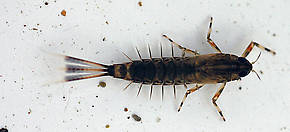 View 2 Pictures
View 2 Pictures
 View 2 Pictures
View 2 PicturesCollected March 5, 2005 from the Flathead River-lower in Montana
Added to Troutnut.com by Bnewell on June 28, 2011
Added to Troutnut.com by Bnewell on June 28, 2011
Baetidae (Blue-Winged Olives) Mayfly Nymph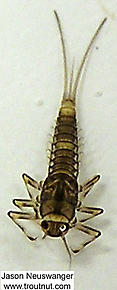 View 3 PicturesThis relatively large early March Baetid nymph has untracheated gills and no bands on its tails.
View 3 PicturesThis relatively large early March Baetid nymph has untracheated gills and no bands on its tails.
 View 3 PicturesThis relatively large early March Baetid nymph has untracheated gills and no bands on its tails.
View 3 PicturesThis relatively large early March Baetid nymph has untracheated gills and no bands on its tails.Collected March 9, 2004 from unknown in Wisconsin
Added to Troutnut.com by Troutnut on January 25, 2006
Added to Troutnut.com by Troutnut on January 25, 2006
Rhithrogena hageni (Western Black Quill) Mayfly Nymph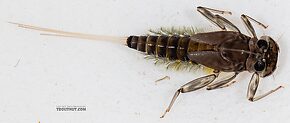 View 9 PicturesI'm basing the ID of this near-mature nymph on a male spinner with similar size and markings, collected on the same trip. There isn't a key to reliably identify the nymphs of most Rhithrogena species otherwise.
View 9 PicturesI'm basing the ID of this near-mature nymph on a male spinner with similar size and markings, collected on the same trip. There isn't a key to reliably identify the nymphs of most Rhithrogena species otherwise.
 View 9 PicturesI'm basing the ID of this near-mature nymph on a male spinner with similar size and markings, collected on the same trip. There isn't a key to reliably identify the nymphs of most Rhithrogena species otherwise.
View 9 PicturesI'm basing the ID of this near-mature nymph on a male spinner with similar size and markings, collected on the same trip. There isn't a key to reliably identify the nymphs of most Rhithrogena species otherwise.Collected July 4, 2020 from Mystery Creek #249 in Washington
Added to Troutnut.com by Troutnut on July 12, 2020
Added to Troutnut.com by Troutnut on July 12, 2020
Female Ephemerellidae (Hendricksons, Sulphurs, PMDs, BWOs) Mayfly Dun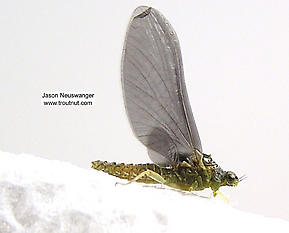 View 4 Pictures
View 4 Pictures
 View 4 Pictures
View 4 PicturesCollected August 4, 2004 from unknown in Wisconsin
Added to Troutnut.com by Troutnut on January 19, 2006
Added to Troutnut.com by Troutnut on January 19, 2006
Female Ephemerellidae (Hendricksons, Sulphurs, PMDs, BWOs) Mayfly Spinner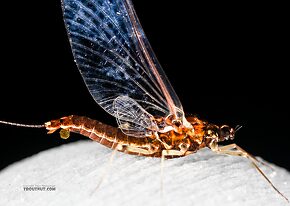 View 6 Pictures
View 6 Pictures
 View 6 Pictures
View 6 PicturesCollected August 1, 2020 from Mystery Creek #237 in Montana
Added to Troutnut.com by Troutnut on August 18, 2020
Added to Troutnut.com by Troutnut on August 18, 2020
Male Cinygmula par Mayfly Spinner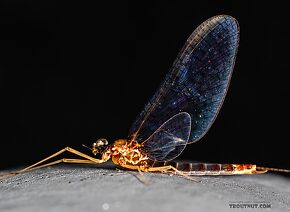 View 9 PicturesThis specimen was collected from a swarm with a female and another male.
View 9 PicturesThis specimen was collected from a swarm with a female and another male.
 View 9 PicturesThis specimen was collected from a swarm with a female and another male.
View 9 PicturesThis specimen was collected from a swarm with a female and another male.Collected July 4, 2020 from Mystery Creek #249 in Washington
Added to Troutnut.com by Troutnut on July 12, 2020
Added to Troutnut.com by Troutnut on July 12, 2020
Ameletus (Brown Duns) Mayfly Nymph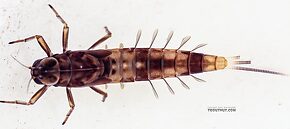 View 6 PicturesI spent (Spent: The wing position of many aquatic insects when they fall on the water after mating. The wings of both sides lay flat on the water. The word may be used to describe insects with their wings in that position, as well as the position itself.) ages trying to identify this one but ultimately couldn't narrow it down to species. I'm guessing it's either a species that has not yet been reported from Idaho or a species with some variation in characteristics not accounted for in the current key (Zloty 1997), which is only for Alberta but happens to contain all the species documented in Idaho except for one (which is rare and only in a different part o the state from this one).
View 6 PicturesI spent (Spent: The wing position of many aquatic insects when they fall on the water after mating. The wings of both sides lay flat on the water. The word may be used to describe insects with their wings in that position, as well as the position itself.) ages trying to identify this one but ultimately couldn't narrow it down to species. I'm guessing it's either a species that has not yet been reported from Idaho or a species with some variation in characteristics not accounted for in the current key (Zloty 1997), which is only for Alberta but happens to contain all the species documented in Idaho except for one (which is rare and only in a different part o the state from this one).
Here are my raw notes from the microscope session:
8. Ameletus nymph (genus 100 % based on mouth parts under microscope)
1. This is probably a species with the nymph either not described yet or not reported in Idaho (or Alberta).
2. There is a key to the species of nymphs in Alberta (Zloty 1997) which includes all but one (A. tolae) of the species listed in Idaho by IDFG (https://idfg.idaho.gov/species/taxa/8607), and A. tolae is only listed from one drainage in north-central Idaho. So my specimen should be in that key. However, it doesn’t fit any of them.
1. The antennae are pale with brown at the apex (Apex: The uppermost, outermost, or culminating point; the tip.). This doesn’t fit any of the species they described.
2. The labrum (Labrum: The platelike structure forming the roof of the mouth of insects; the upper lip.) is almost completely dark brown, maybe a bit paler toward the apex (Apex: The uppermost, outermost, or culminating point; the tip.).
3. Following the key in Zloty 1997 basically rules out every species reported in Idaho except for tolae, which would be outside its range:
1. Couplet 1 : There definitely aren’t strong ganglionic markings on sternites (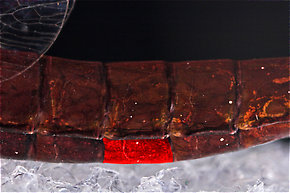 Sternite: The bottom (ventral) part of a single segment on an insect's abdomen.) 2-8 (100 % rules out similior and celer) —> 3
Sternite: The bottom (ventral) part of a single segment on an insect's abdomen.) 2-8 (100 % rules out similior and celer) —> 3
2. Couplet 3 : Posterior (Posterior: Toward the back of an organism's body. The phrase "posterior to" means "in back of.") margins of sternites ( Sternite: The bottom (ventral) part of a single segment on an insect's abdomen.) 6-8 lack large spines (80 % sure) but other characteristics rule out the species if there were spines (validus, oregonensis, subnotatus) —> 6
Sternite: The bottom (ventral) part of a single segment on an insect's abdomen.) 6-8 lack large spines (80 % sure) but other characteristics rule out the species if there were spines (validus, oregonensis, subnotatus) —> 6
3. Couplet 6 : Mesal (Mesal: Toward the middle.) gill extension present, but pretty slim… similar to Fig. 23B or 23G —> 7
4. Couplet 7 : Obviouly gos to 8
5. Couplet 8 : Small size and time of year rules out velox, tergite (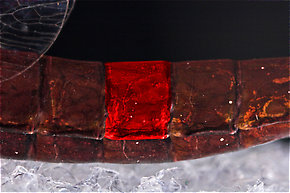 Tergite: The top (dorsal) part of a single segment on an insect's abdomen when it consists of a single chitinous plate (sclerite), or an individual sclerite if the segment has more than one.) patterna and gill shape rules out pritchardi (which is not reported in Idaho anyway). Additional features (antennae, labrum (Labrum: The platelike structure forming the roof of the mouth of insects; the upper lip.) color) rule out a small velox.
Tergite: The top (dorsal) part of a single segment on an insect's abdomen when it consists of a single chitinous plate (sclerite), or an individual sclerite if the segment has more than one.) patterna and gill shape rules out pritchardi (which is not reported in Idaho anyway). Additional features (antennae, labrum (Labrum: The platelike structure forming the roof of the mouth of insects; the upper lip.) color) rule out a small velox.
6. Backtrack to call the mesal (Mesal: Toward the middle.) gill extension “well developed” —> 9
7. Couplet 9 : Tail coloration obviously —> 10
8. Couplet 10 : Supposing it’s a small specimen of a “larger species” leads to 11, in which femora (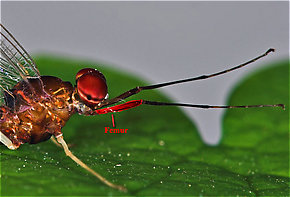 Femur: The main segment of an insect's leg close to the body, in between the tibia and the trochanter.) coloration and timing rule out vernalis, and color pattern rules out bellulus. Mesal (Mesal: Toward the middle.) extension on gills from species description very conclusively rules out bellulus. Therefore, calling it a “smaller species” is the correct path —> 12
Femur: The main segment of an insect's leg close to the body, in between the tibia and the trochanter.) coloration and timing rule out vernalis, and color pattern rules out bellulus. Mesal (Mesal: Toward the middle.) extension on gills from species description very conclusively rules out bellulus. Therefore, calling it a “smaller species” is the correct path —> 12
9. Couplet 12 : Sternites ( Sternite: The bottom (ventral) part of a single segment on an insect's abdomen.) without well-defined longitudinal stripe —> cooki. However, tergite (
Sternite: The bottom (ventral) part of a single segment on an insect's abdomen.) without well-defined longitudinal stripe —> cooki. However, tergite ( Tergite: The top (dorsal) part of a single segment on an insect's abdomen when it consists of a single chitinous plate (sclerite), or an individual sclerite if the segment has more than one.) color patterns don’t even come close to matching ANY of the 3 species from this point on (cooki, sparsatus, suffusus). From the species descriptions:
Tergite: The top (dorsal) part of a single segment on an insect's abdomen when it consists of a single chitinous plate (sclerite), or an individual sclerite if the segment has more than one.) color patterns don’t even come close to matching ANY of the 3 species from this point on (cooki, sparsatus, suffusus). From the species descriptions:
1. cooki: Antenna and labrum (Labrum: The platelike structure forming the roof of the mouth of insects; the upper lip.) colors don’t fit. Mesal (Mesal: Toward the middle.) extension should be larger and tracheation lighter, to be this species.
2. sparsatus: Antenna and labrum (Labrum: The platelike structure forming the roof of the mouth of insects; the upper lip.) colors don’t fit. Mesal (Mesal: Toward the middle.) extension should be larger. Postero-lateral (Lateral: To the side.) spines should be very prominent, not barely noticeable.
3. suffusus: Also bad fit to antenna and labrum (Labrum: The platelike structure forming the roof of the mouth of insects; the upper lip.) colors, mesal (Mesal: Toward the middle.) extension, and especially gill tracheation.
 View 6 PicturesI spent (Spent: The wing position of many aquatic insects when they fall on the water after mating. The wings of both sides lay flat on the water. The word may be used to describe insects with their wings in that position, as well as the position itself.) ages trying to identify this one but ultimately couldn't narrow it down to species. I'm guessing it's either a species that has not yet been reported from Idaho or a species with some variation in characteristics not accounted for in the current key (Zloty 1997), which is only for Alberta but happens to contain all the species documented in Idaho except for one (which is rare and only in a different part o the state from this one).
View 6 PicturesI spent (Spent: The wing position of many aquatic insects when they fall on the water after mating. The wings of both sides lay flat on the water. The word may be used to describe insects with their wings in that position, as well as the position itself.) ages trying to identify this one but ultimately couldn't narrow it down to species. I'm guessing it's either a species that has not yet been reported from Idaho or a species with some variation in characteristics not accounted for in the current key (Zloty 1997), which is only for Alberta but happens to contain all the species documented in Idaho except for one (which is rare and only in a different part o the state from this one).Here are my raw notes from the microscope session:
8. Ameletus nymph (genus 100 % based on mouth parts under microscope)
1. This is probably a species with the nymph either not described yet or not reported in Idaho (or Alberta).
2. There is a key to the species of nymphs in Alberta (Zloty 1997) which includes all but one (A. tolae) of the species listed in Idaho by IDFG (https://idfg.idaho.gov/species/taxa/8607), and A. tolae is only listed from one drainage in north-central Idaho. So my specimen should be in that key. However, it doesn’t fit any of them.
1. The antennae are pale with brown at the apex (Apex: The uppermost, outermost, or culminating point; the tip.). This doesn’t fit any of the species they described.
2. The labrum (Labrum: The platelike structure forming the roof of the mouth of insects; the upper lip.) is almost completely dark brown, maybe a bit paler toward the apex (Apex: The uppermost, outermost, or culminating point; the tip.).
3. Following the key in Zloty 1997 basically rules out every species reported in Idaho except for tolae, which would be outside its range:
1. Couplet 1 : There definitely aren’t strong ganglionic markings on sternites (

One sternite of this Isonychia bicolor mayfly spinner is highlighted in red.
2. Couplet 3 : Posterior (Posterior: Toward the back of an organism's body. The phrase "posterior to" means "in back of.") margins of sternites (

One sternite of this Isonychia bicolor mayfly spinner is highlighted in red.
3. Couplet 6 : Mesal (Mesal: Toward the middle.) gill extension present, but pretty slim… similar to Fig. 23B or 23G —> 7
4. Couplet 7 : Obviouly gos to 8
5. Couplet 8 : Small size and time of year rules out velox, tergite (

One tergite of this Isonychia bicolor mayfly spinner is highlighted in red.
6. Backtrack to call the mesal (Mesal: Toward the middle.) gill extension “well developed” —> 9
7. Couplet 9 : Tail coloration obviously —> 10
8. Couplet 10 : Supposing it’s a small specimen of a “larger species” leads to 11, in which femora (

The femur of this Isonychia bicolor mayfly spinner is highlighted in red.
9. Couplet 12 : Sternites (

One sternite of this Isonychia bicolor mayfly spinner is highlighted in red.

One tergite of this Isonychia bicolor mayfly spinner is highlighted in red.
1. cooki: Antenna and labrum (Labrum: The platelike structure forming the roof of the mouth of insects; the upper lip.) colors don’t fit. Mesal (Mesal: Toward the middle.) extension should be larger and tracheation lighter, to be this species.
2. sparsatus: Antenna and labrum (Labrum: The platelike structure forming the roof of the mouth of insects; the upper lip.) colors don’t fit. Mesal (Mesal: Toward the middle.) extension should be larger. Postero-lateral (Lateral: To the side.) spines should be very prominent, not barely noticeable.
3. suffusus: Also bad fit to antenna and labrum (Labrum: The platelike structure forming the roof of the mouth of insects; the upper lip.) colors, mesal (Mesal: Toward the middle.) extension, and especially gill tracheation.
Collected August 4, 2020 from Green Lake Outlet in Idaho
Added to Troutnut.com by Troutnut on August 20, 2020
Added to Troutnut.com by Troutnut on August 20, 2020
Female Siphlonurus occidentalis (Gray Drake) Mayfly Dun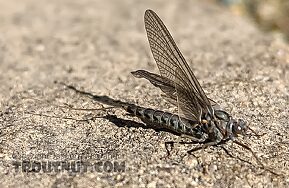 View 6 PicturesI caught this specimen two days' walk from my macro lenses, but I don't think I have a dun of this species yet, so I took the best photos I could with my iPhone.
View 6 PicturesI caught this specimen two days' walk from my macro lenses, but I don't think I have a dun of this species yet, so I took the best photos I could with my iPhone.
 View 6 PicturesI caught this specimen two days' walk from my macro lenses, but I don't think I have a dun of this species yet, so I took the best photos I could with my iPhone.
View 6 PicturesI caught this specimen two days' walk from my macro lenses, but I don't think I have a dun of this species yet, so I took the best photos I could with my iPhone.Collected August 30, 2020 from Island Lake in Wyoming
Added to Troutnut.com by Troutnut on September 18, 2020
Added to Troutnut.com by Troutnut on September 18, 2020
Top 10 Fly Hatches
Top Gift Shop Designs
Eat mayflies.
Top Insect Specimens
Miscellaneous Sites
Troutnut.com is copyright © 2004-2024 Jason
Neuswanger (email Jason). See my FAQ for information about use of my images.
 privacy policy
privacy policy
